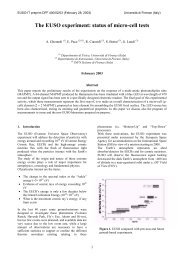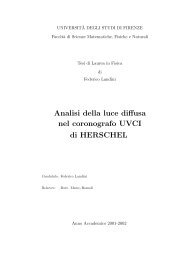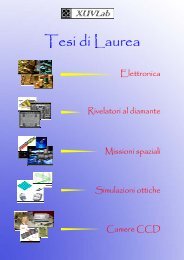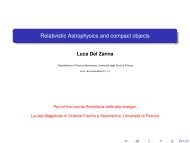2003 - Astronomia - Università degli Studi di Firenze
2003 - Astronomia - Università degli Studi di Firenze
2003 - Astronomia - Università degli Studi di Firenze
Create successful ePaper yourself
Turn your PDF publications into a flip-book with our unique Google optimized e-Paper software.
Diamond detectors<br />
The use of wide bandgap materials for the fabrication of UV and X-ray detectors for various<br />
applications (e.g. space missions, dosimetry, beam monitoring) [Nuclear Instrument] is one of the<br />
main research areas at XUVLab. In particular our activity concerns synthetic <strong>di</strong>amond for the<br />
realization of single pixel and recently bi<strong>di</strong>mensional array detectors. Our research in this field is aimed at<br />
the selection of the most suitable material among the <strong>di</strong>fferent types of presently available synthetic<br />
<strong>di</strong>amonds and at the investigation of the various pixel and array geometries.The available <strong>di</strong>amond<br />
samples are grown both by HPHT (High Pressure High Temperature) technique and CVD (Chemical Vapour<br />
Deposition), on <strong>di</strong>amond and non-<strong>di</strong>amond substrates, and have <strong>di</strong>fferent origin: some of them have<br />
commercial source (De Beers Industrial Diamond, Fraunhofer Institute of Technologies, Sumitomo) and<br />
some others are grown by research groups (Dep. of Mechanical Engineering, Rome University “Tor<br />
Vergata”, University of Augsburg). The quality of the crystals, the presence of graphite in the grain<br />
boundaries, the impurity and defect content are assessed using Raman and photoluminescence<br />
spectroscopy. Gold electrodes are deposited on selected films to fabricate photoconductive devices<br />
both in coplanar and “sandwich” geometry (see figure). After that the nature of the electrical contacts is<br />
evaluated by dark current measurements and the electro-optical performance (efficiency spectrum,<br />
rejection to visible ra<strong>di</strong>ation, response time) is investigated irra<strong>di</strong>ating the samples with monochromatic<br />
illumination in the range between 30 nm and 270 nm [1, 2]. Illumination transients provide information on<br />
the time response and on its dependence on material typology, voltage biasing, wavelength, ra<strong>di</strong>ation<br />
intensity and pixel geometry.<br />
<strong>di</strong>amond layer<br />
back electrode<br />
inter<strong>di</strong>gitated coplanar electrodes<br />
Recently single-crystal 2a-type CVD films grown on 1b-type HPHT <strong>di</strong>amond substrates have emerged as<br />
deeply interesting for the realization of detectors, showing high structural quality and good<br />
photoconductive behaviour in terms of efficiency, signal-to-noise ratio and rejection to sub-bandgap<br />
ra<strong>di</strong>ation [3]. Also the CVD technique has achieved a high degree of perfection, making possible the<br />
synthesis of high quality polycrystalline samples, which can be obtained growing films up to ~1 mm<br />
thickness and removing the substrate and most of the nucleation region. In this way samples with<br />
columnar grains and low defect content can be obtained, with a positive effect also on the<br />
photoconductive behaviour [5]. Thus our latest experimental results concerning the research of the best<br />
material suggest that both monocrystalline and high quality polycrystalline CVD <strong>di</strong>amond films open new<br />
interesting opportunities for the realization of high performing UV sensors.Another experimental activity<br />
concerns the feasibility study of imaging detectors based on <strong>di</strong>amond films. With this respect, it is<br />
interesting to observe that the “sandwich” configuration makes the realization of bi<strong>di</strong>mensional arrays<br />
much simpler than the coplanar one, making possible the packaging of pixels covering the whole film<br />
surface. For this reason the behaviour of some devices with “sandwich” geometry has been stu<strong>di</strong>ed by<br />
electro-optical measurements.<br />
XUVLab activity summary <strong>2003</strong><br />
detectors developements 15









